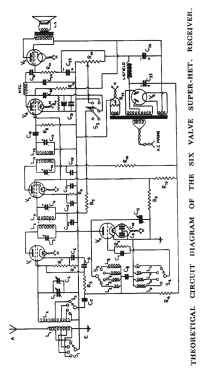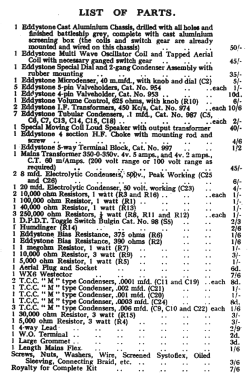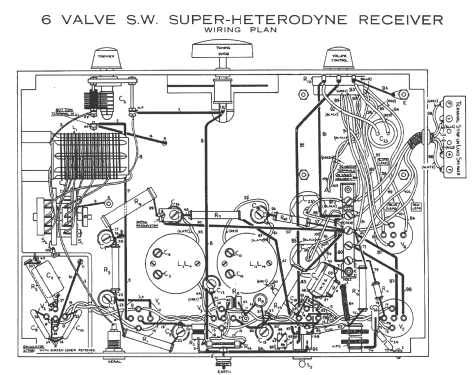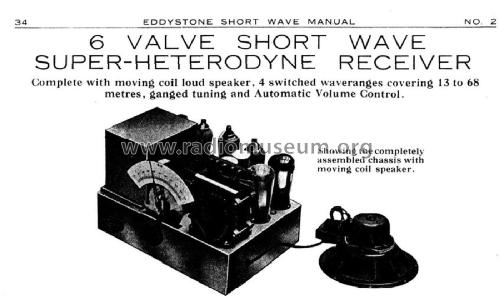Six-Valve Shortwave Superheterodyne
Eddystone (Brand), Stratton and Co., Ltd., Eddystone Radio Ltd.; Birmingham
- Pays
- Royaume Uni
- Fabricant / Marque
- Eddystone (Brand), Stratton and Co., Ltd., Eddystone Radio Ltd.; Birmingham
- Année
- 1935 ?
- Catégorie
- Boîte de construction (composants et manuel) ou instructions
- Radiomuseum.org ID
- 355308
Cliquez sur la vignette du schéma pour le demander en tant que document gratuit.
- No. de tubes
- 6
- No. de transistors
- Semi-conducteurs
- WX6
- Principe général
- Super hétérodyne (en général)
- Gammes d'ondes
- OC uniquement
- Tension / type courant
- Alimentation Courant Alternatif (CA)
- Haut-parleur
- HP dynamique à électro-aimant (électrodynamique)
- Matière
- Boitier métallique, lampes visibles
- De Radiomuseum.org
- Modèle: Six-Valve Shortwave Superheterodyne - Eddystone Brand, Stratton and
- Forme
- Chassis (pour intégration dans meuble)
- Remarques
-
Six-Valve Shortwave Superheterodyne Kitset: Detailed Breakdown
This kitset offers a complete shortwave radio experience, featuring:
- Six Valves: This includes a full-wave rectifier for power conversion and a metal rectifier for automatic volume control (AVC).
- Superheterodyne Design: It employs the superheterodyne principle, converting received signals to a fixed intermediate frequency (IF) for easier amplification and filtering.
Signal Processing Stages:
- First Detector: A screened-grid valve functions as an anode-bend rectifier, converting the received radio signal to an IF signal.
- Local Oscillator: A separate triode valve generates the necessary oscillation signal for frequency mixing in the superheterodyne process.
- Intermediate Frequency (IF) Amplifier: A variable-mu-screened pentode amplifies the IF signal at a fixed frequency of 450 kHz.
- Second Detector: A screened high-frequency pentode with power grid rectification demodulates the IF signal to recover the audio information. This stage uses resistance coupling to connect to the output valve.
- Output Stage: A directly heated pentode valve provides power amplification for the audio signal.
Tuning and Controls:
- Ganged Tuning: A ganged capacitor simplifies tuning by adjusting both the antenna circuit and oscillator simultaneously across four-wave ranges. A small trimmer capacitor fine-tunes the antenna circuit for optimal reception.
- Four Wave Ranges: The switchable wave ranges cover a broad spectrum from 13 to 68 metres, approximately 21.4 to 4.4 MHz.
- Automatic Volume Control (AVC): An AVC circuit with a dedicated metal rectifier (WX6) automatically adjusts the gain to maintain consistent audio volume even with varying signal strengths. A switch allows you to bypass the AVC and use a manual volume control for more precise adjustments.
Construction Details:
- Robust Chassis: The receiver, including the power supply, is built on a sturdy cast aluminum alloy chassis, providing a reliable foundation for assembly.
- Effective Shielding: The coil unit utilizes a one-piece metal casting to shield the oscillator circuit, minimizing unwanted signal interactions (interlocking).
- High-Quality Transformer: The mains transformer is designed for exceptional performance, ensuring good voltage regulation without overheating.
Further Information:
This kitset was comprehensively described in Eddystone Shortwave Manual No. 2 (1935), on pages 34-38.
- Littérature
- - - Manufacturers Literature (Eddystone Shortwave Manual No. 2 1935, Pages 34 - 38)
- Auteur
- Modèle crée par Gary Cowans. Voir les propositions de modification pour les contributeurs supplémentaires.
- D'autres Modèles
-
Vous pourrez trouver sous ce lien 255 modèles d'appareils, 125 avec des images et 46 avec des schémas.
Tous les appareils de Eddystone (Brand), Stratton and Co., Ltd., Eddystone Radio Ltd.; Birmingham



